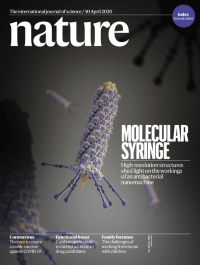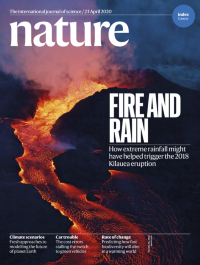Volume 580
-
No. 7805 30 April 2020
Molecular syringeThe cover shows an artist’s impression of an R-type bacteriocin protein complex from the bacterium Pseudomonas aeruginosa. Bacteriocins are contractile molecular syringes — nanomachines produced by one bacterium that can puncture the cell membrane of another bacterium to deliver a lethal punch. In this week’s issue, Hong Zhou and his colleagues present high-resolution structures of the bacteriocin pyocin R2 from P. aeruginosa in both its pre- and post-contraction states. The results allow the researchers to suggest in detail how the molecular syringe works, offering insight into how R-type bacteriocins might be developed into a new class of antimicrobials.
Nature Index
-
No. 7804 23 April 2020
Fire and rainThe cover shows lava flow on Kīlauea volcano in Hawaii during the rift eruption in 2018. In this week’s issue, Jamie Farquharson and Falk Amelung present modelling evidence that the massive outpouring of lava might have been prompted by extreme rainfall. Although it is known that rainfall can modulate shallow volcanic activity, it has been unclear if it can exert influence at the greater depths associated with magma movement. The researchers propose that the unusually heavy rainfall during the months before the 2018 eruption infiltrated the volcano’s subsurface, increasing the pressure exerted by groundwater to a 50-year high. This would have weakened the rock, creating fractures and allowing magma to rise up at new locations, ultimately precipitating the eruption. Farquharson and Amelung reviewed the history of Kīlauea’s eruptions since 1790 and found that around 60% of them occurred during the wettest parts of the year. They suggest that a better understanding of the potential coupling of rainfall and volcanism could improve forecasts of volcanic activity.
Nature Index
-
No. 7803 16 April 2020
The mirror crack’dA fundamental question about the formation of the Universe is how there came to be more matter present than antimatter. It is thought that this disparity is related to a violation of fundamental physics. The laws of physics are essentially symmetrical — what holds true for matter particles in our Universe should also be true for antimatter particles in a mirror universe. But this is not always the case, and it has been shown that quarks do not behave in quite the same way as their mirror-image antiquarks. Such symmetry violation — known as charge-conjugation and parity reversal (CP) violation — has not yet been demonstrated for leptons, the class of fundamental particle that includes electrons, muons and neutrinos. This issue sees a substantial advance in the search for this violation, as the T2K Collaboration reports measurements on discrepancies between neutrinos and antineutrinos with a 99.7% confidence level, leading to an indication of CP violation at the 95% confidence level. Using the Super-Kamiokande detector (pictured) to capture neutrinos produced 295 kilometres away at the J-PARC accelerator complex in Tokai, Japan, the team determined that the probability of a muon neutrino becoming an electron neutrino seems to be different from that of a muon antineutrino becoming an electron antineutrino, thereby providing an indication of CP violation in leptons. If confirmed by more precise measurements in the future, this violation may help point the way to an explanation of how excess matter was formed in our Universe.
-
No. 7802 9 April 2020
Clearing the bottleneckPlastic waste is a major environmental issue, with some 200 million tonnes accumulating in landfill or the natural environment each year. One significant contributor to the problem is poly(ethylene terephthalate) (PET), which is widely used to make plastic bottles and is not easy to recycle. In this week’s issue, Alain Marty and his colleagues report that they have engineered an enzyme that at a pilot scale can efficiently break PET down into its monomer constituents. After 10 hours, the team’s PET hydrolase can depolymerize PET by at least 90%. More importantly, the resulting purified monomers have the same properties as those freshly generated from petrochemical feedstocks and so can be reused to make bottles, thereby moving closer to the idea of a circular economy based on PET.
-
No. 7801 2 April 2020
Polar oppositeThe cover shows an artist’s impression of the temperate rainforest that existed in West Antarctica some 90 million years ago. The mid-Cretaceous period basked in some of the warmest temperatures of the past 140 million years and there has been much debate over whether polar ice could exist at such elevated temperatures. In this week’s issue, Johann Klages and his colleagues present their analysis of a sedimentary sequence from the West Antarctic shelf and show that a temperate rainforest-like ecosystem existed in West Antarctica during the Turonian–Santonian age (92 million to 83 million years ago). The cored sediments feature a 3-metre-long network of fossil roots embedded in a mudstone matrix bearing diverse pollen and spores. A climate model to reconstruct the climate for the forest suggests that Antarctica would have been free of ice and that the atmospheric carbon dioxide concentration was 1,120–1,680 parts per million, much more than the 407 parts per million of today.





